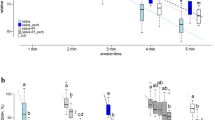Abstract
The purpose of the present in vivo study was to examine salivary pellicle formation on enamel surfaces at two different intraoral sites for periods of 1 min up to 24 h by means of transmission electron microscopy. Bovine enamel specimens were attached to the buccal and lingual surfaces of the upper first molars in three subjects using removable intraoral splints. Specimens were carried over periods of 1, 10, 30 and 60 min, 2, 6 and 24 h and were processed for transmission electron microscopy. After 1 min, an electron dense pellicle layer, 10–20 nm thick, was observed on the enamel surfaces. The subsequent adsorption of salivary biopolymers was governed by local influences of the oral cavity. Specimens located on the lingual aspect were covered within 2 h by a 20- to 80-nm-thick, homogeneous, predominantly granular-structured pellicle. The thickness of the surface coatings that were adsorbed on lingually carried specimens increased to 100–200 nm after 24 h. In contrast, on the buccally mounted specimen surfaces, a variably structured pellicle with granular and globular components could be detected after intraoral exposure for 2 h. The thickness of the 2-h buccal pellicles ranged between 200 and 700 nm. After 24 h, the buccally positioned specimens were covered by a dense globular pellicle layer varying in thickness from 1000 to 1300 nm. It is suggested that in vivo pellicle formation is initiated by adsorption of an electron-dense layer of salivary proteins. Further adsorption of salivary biopolymers leads to the formation of an outer loosely arranged pellicle layer. Under oral conditions, the locally available salivary biopolymers and the influence of locally effective shearing forces are of significance for the ultrastructural pattern and extent of pellicle formation.
Similar content being viewed by others
Author information
Authors and Affiliations
Additional information
Received: 8 March 1999 / Accepted: 19 April 1999
Rights and permissions
About this article
Cite this article
Hannig, M. Ultrastructural investigation of pellicle morphogenesis at two different intraoral sites during a 24-h period. Clinical Oral Investigations 3, 88–95 (1999). https://doi.org/10.1007/s007840050084
Issue Date:
DOI: https://doi.org/10.1007/s007840050084




